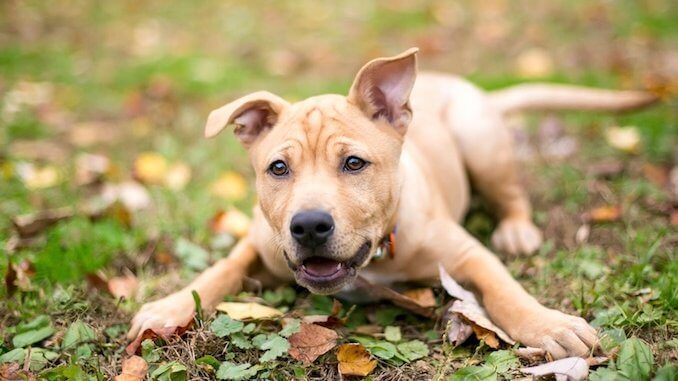
Bringing home a puppy is a wonderful and exciting experience; it’s also the best time to start their training.
These first few weeks are filled with special achievements, development milestones and important bonding time.
However, you are likely going to be faced by boisterous and obnoxious behavior almost immediately! Think pooping, biting, chewing, whining and growling.
Proper care (socialization, vaccinations and training) is critical during your puppy’s first few months in your home.
As a puppy parent you must be responsible and take a few steps to ensure they mature into a well-behaved dog.
We have spoken with 45 professional dog trainers, handlers and experts and rounded up their best advice to give you a free guide for puppy raising.
Embed Code
Feel free to share our puppy training tips on your website by using the code below.
<a href="https://www.allthingsdogs.com/puppy-training-tips/"><img src="https://www.allthingsdogs.com/wp-content/uploads/2018/08/Puppy-Training-Tips.png" alt="Puppy Training Infographic" width="1024" height="2809" /></a><br /> Provided by - <a href="https://www.allthingsdogs.com/">All Things Dogs</a>
TABLE OF CONTENTS
45 Puppy Training Tips from Experts
1. Ensure Good Doggie Social Skills
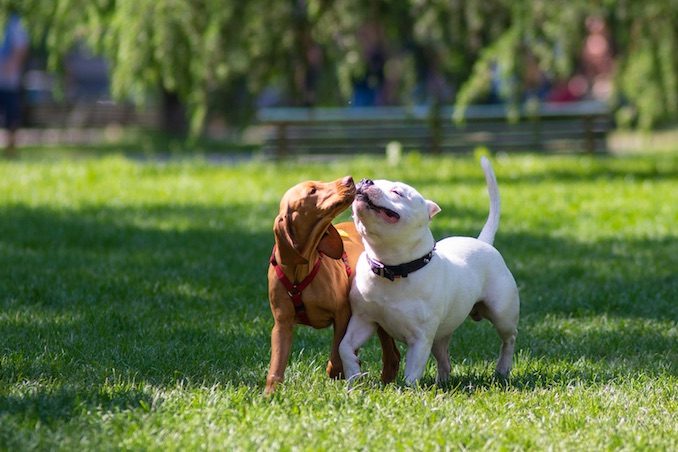 Take your puppy and a small Zip-Lock bag full of his puppy food with you everywhere you can.
Take your puppy and a small Zip-Lock bag full of his puppy food with you everywhere you can.
Introduce him to at least a hundred different people during the first five months of his life and have those people feed him treats.
Enroll him in a puppy kindergarten class that has puppy playtime to help him learn good doggie social-skills and control of the pressure of his bite, called Bite-inhibition.
Take him to a lot of different locations and make the outings fun.
A lot of obedience training can be taught when your puppy is older without serious ramifications, but the window for socialization and teaching bite-inhibition is very small and those two things will most effect your dog’s temperament as an adult.
Without proper socialization your dog may develop aggression or fear issues, which are very hard to treat later on.
If your puppy has not had enough vaccines to protect him from disease yet, then carry him when you take him to places where other dogs have been.
You do not have to wait to take him places if you carry him where other animals have been or take him to places where there are no dogs present, like friend’s homes – via Caitlin.
2. Make Training and Socializing Positive
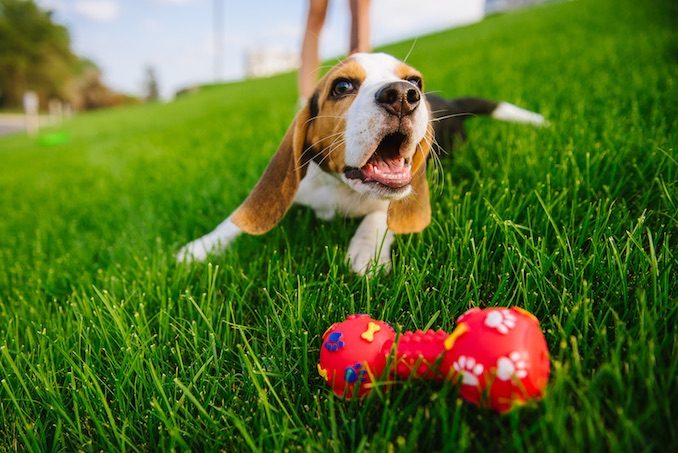 Getting a puppy is loads of fun and work.
Getting a puppy is loads of fun and work.
Remember to be patient, loving and kind.
Having a pet is a 24-7 commitment. The unconditional love they give is amazing. But remember they need some direction. Try to make your training and socializing a positive and good thing.
Treat reward training is great way to go.
Find a trainer with positive methods that you like and feel comfortable with. You can take your puppy to socialization classes, so sign up.
Hopefully they will cover questions on puppy biting, chewing on things, potty training, crate training, and other questions.
No question is a dumb question, so ask away. If you don’t ask, how are you going to find out. If you choose group classes you also find out, that you are not alone.
Other owners are going through the same thing. Try to stay optimistic. Aim to make your puppy optimistic – via Mary Jackson.
3. Socialize your Puppy
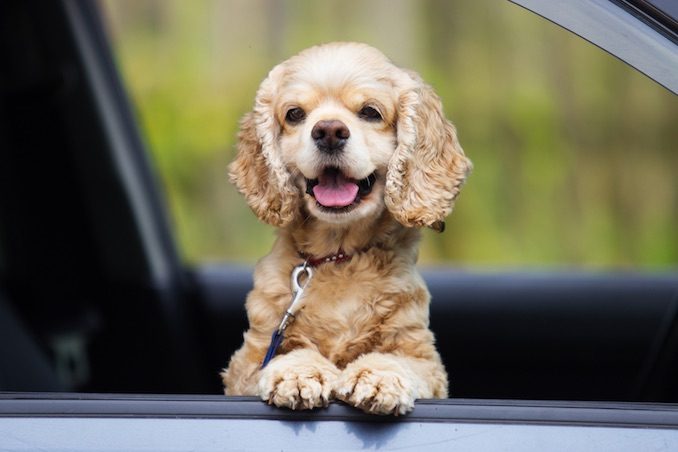 Socialize your puppy so that your puppy meets LOTS of different people different ethnic backgrounds and demographics such as small kids, men, women etc…
Socialize your puppy so that your puppy meets LOTS of different people different ethnic backgrounds and demographics such as small kids, men, women etc…
Your puppy should interact with people and any novel thing such as riding in the car, wearing a harness by using positive associations.
Food works very well because we all love food. That is one of the reasons reward based trainers use food in training.
Most people do the bare minimum when it comes to socializing a young puppy.
Do keep in mind that from ages of 3 weeks to 12 weeks of age, puppies are like sponges, learning very easily.
Beyond this early socialization period you will be playing catch up – via Almudena.
4. Say Commands Only Once
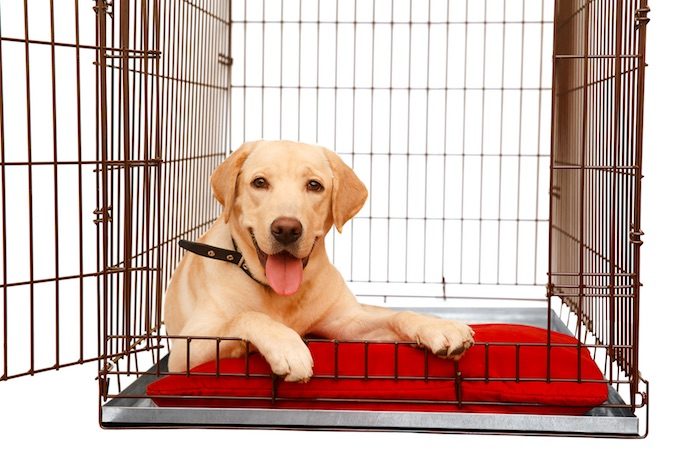 Be patient, be kind. Your pup wants to please you. Remember to be consistent.
Be patient, be kind. Your pup wants to please you. Remember to be consistent.
Say a command only once, then show direction so the dog understands. Repeating the “SIT” command 6 X does not make a pup understand.
Crate training a dog to help house break has proven to be a very successful and kind way to teach your dog control over his bladder.
Never use it as punishment.
It is to be used as a safe, quiet, “den” type of feeling for your pup.
He will learn quickly.
He won’t want to soil his den. You both will be happier.
It also helps with separation anxiety;
When he comes to know and love his den, he will feel very comfortable waiting for your return. Start by leaving him for very short periods. He will learn you return, and that he isn’t left. Then, as you extend the time, he will rest quietly and be happy to see you.
Most of all be his friend. Play with him. Have him feel that being with you is the best place in whole world to be. You won’t regret it! – via Carol Minker.
5. Ensure Play Sessions With Other Puppies
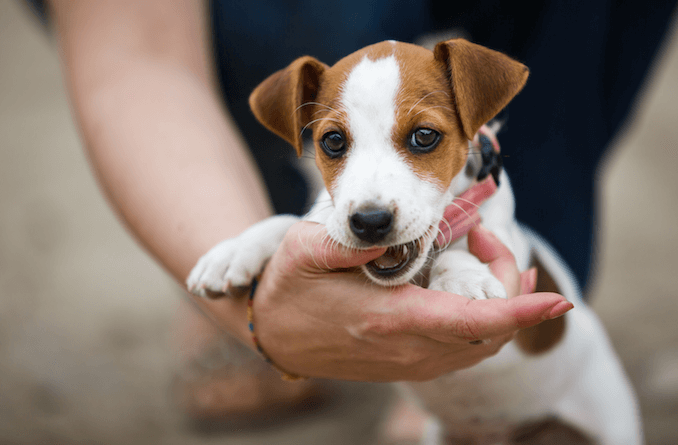
The number one reason puppies mouth (i.e. put their teeth on humans) is not enough play with other puppies.
In my behavior consult practice when I see this complaint, the puppy is either an only dog in the house or the other dog is too old to play with the puppy.
When we take puppies away from their litter mates, they are still at a developmental stage that demands mouth-on play with other canines.
I recommend play sessions with other puppies or gentle older dogs 3-5 times a week at a minimum.
Play should be a positive experience for the puppy and the puppy should not be a bully or be bullied.
One-on-one play sessions are ideal, but group play should not be more than 8 puppies. During the play session there should be happy, bouncy interactions.
While there may be a lot of noise and slobber, and even teeth clanking, there should never be blood (unless someone has just lost a baby tooth) – via Michele.
6. Gain Their Trust and Form a Bond
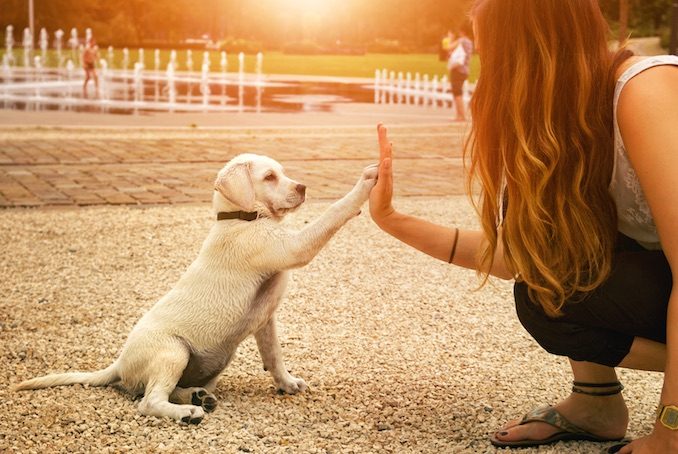 The very first thing to do with a puppy is gain their trust.
The very first thing to do with a puppy is gain their trust.
Forming a bond is paramount to having a good relationship, which makes learning easier and have your dog never fear you.
Second most important is teaching the puppy how to stay calm. It’s important for puppies to have an “off switch” for when they nip, steel toys or do puppy things.
I like to teach a relax on a mat.
Socialization is critical too, so taking your puppy out to sanitary puppy classes and places, to meet at least 100 new people each month from ages 2 months to four months.
Finally, house training is crucial; many dogs are turned into shelters simply because owners don’t know the correct way to potty train, so as a trainer, those three things I find to be most important – via Shannon Thier.
7. Train a Puppy to Go to the Bathroom Outside
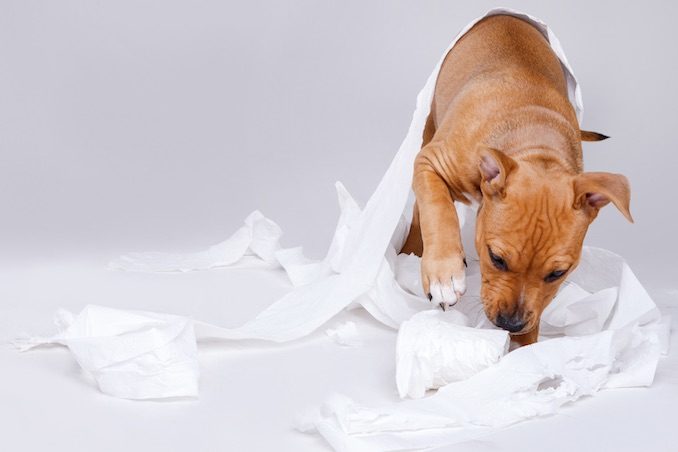 Use a 3x’s a day feeding schedule and learn when you can expect your puppy to need to go. Make sure you don’t have mistakes throughout the house, have a small crate for his/her sleep time and leash your dog outside the cage.
Use a 3x’s a day feeding schedule and learn when you can expect your puppy to need to go. Make sure you don’t have mistakes throughout the house, have a small crate for his/her sleep time and leash your dog outside the cage.
The cage needs to be in a designated area where they see you passing through and you will notice or see when mistakes happen.
You say NO GO POTTY OUTSIDE and take your puppy outside and reward he/she when they go outside.
In this way you can closely monitor your puppy, give them new toys, play with them, take them for walks and return them to the outside of their cage with their leash.
If you often put them in their cage for meals and naptime they will love their cage forever for quiet time and security and if you leash them outside of their cage they will think a leash is second nature – via Mary Stillman.
8. Research How Dogs Learn
 A puppy is not a four legged child, it has the ability to problem solve and will do whatever to get the results he or she believes they need at that moment in time.
A puppy is not a four legged child, it has the ability to problem solve and will do whatever to get the results he or she believes they need at that moment in time.
Do your research on how dogs learn and canine learning theory.
A puppy is a clean slate and with proper guidance can become whatever you teach it to be.
Seek out professional assistance before the issues become life altering to the puppy.
A puppy was born knowing how to be a dog, it is bridging the canine to human communication gap that causes the issues and for some their homes – via Bobbi Graves.
9. Encourage Exploration
 Pair new or scary things with treats and never force your puppy to approach something.
Pair new or scary things with treats and never force your puppy to approach something.
You want them to have a positive association with things they will encounter.
Things like the vacuum, the hair dryer, umbrellas, hats, glasses, elderly, kids, teeens and adults, all sorts of other dogs and puppies.
Start with the vacuum off with treats sprinkled around it and let your puppy approach it on his own terms.
Keep it happy, light and positive. Reward (with a treat, play, praise, or whatever your dog finds rewarding) and IGNORE what you do not like. Negative attention (yelling NO!, pushing off, kneeing in the chest, is still attention).
Dogs do what works.
Behaviors extinguish when they are ignored (i.e. when it doesn’t work) – via Heather Brown.
10. Your Puppy Needs You!
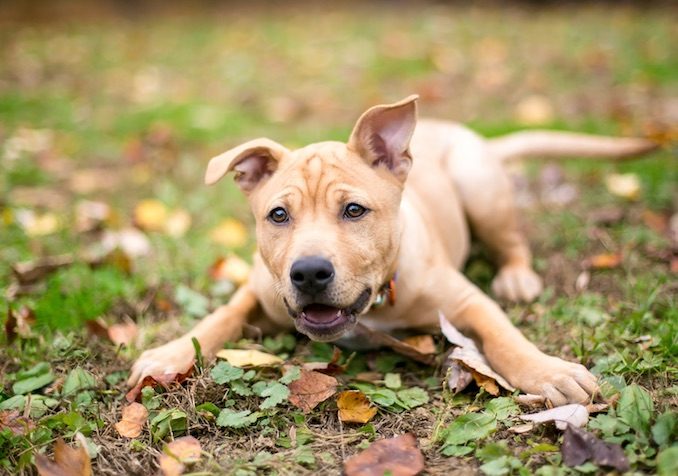 Put yourself on a short leash when the puppy is young.
Put yourself on a short leash when the puppy is young.
Be prepared to stay close to home so you can get the puppy started on the right track.
From house training, socialization and learning the house rules, your puppy needs you!
If you can’t be there plan on hiring a dog walker or asking a friend to help out.
The puppies first few weeks at home help build the foundation for a happy, confident and well behaved dog – via Nancy Schumacher.
11. Teach Your Pooch Vocabulary
Talk and bond with your puppy. Start teaching vocabulary immediately. Share everything that you can with him including food and observations on walks. Introduce him to novel stimuli everyday. Take it slow and enjoy his cuteness – via Roni.
12. Make Learning Fun!
Don’t rough-house play with your puppy. Instead play instructively. Give them a small ball or yarn or to begin with ‘get the ball’ ‘come’ as you roll the ball away and take the ball from their mouth. At first, you will be retrieving the ball of course! “Find the ball’ as you hide the ball with your hand or behind your back – via Mary Stillman.
13. Use Proven Modern Training Methods
When your dog behaves the way you want, you develop a wonderful bond and trust between you. Find a trainer who uses proven modern methods. There is no place for fear or pain when you are teaching. Not for humans or for any animal. So the best piece of advice is to find a qualified trainer that will help you get the behavior you want in a positive loving way – via Carolyn Lincoln.
14. Encourage Positive Experiences Early In Life
Socialize your puppy to avoid problem behaviors associated with being under-exposed to new things. Many dogs that end up in shelters and/or take a long time to get adopted are dogs with fear or overstimulation issues related to minimal exposure to the outside world during their critical socialization period. These issues are easy to avoid with positive experiences early in life – via Kim.
15. Socialize in a Human World
Socialization is not just introducing your puppy to other dogs, it’s also introducing them to people of other genders, ages and races. It’s introducing them to cars and planes and boats. It’s about teaching them to socialize in our human world – via Amanda.
16. Patience and Bond Based Training
My best advice would be to have patience! Understand that it takes time, and persistence. Spend as much time as you can bonding with your puppy, and look into Bond based training. Fun, games and lots of play. Developing a solid relationship with your dog based on the positive will make training fun, and not a chore – via Gretchen.
17. Socialize Before 20 Weeks Old
The most important thing is SOCIALIZATION. Do this as early as 6 weeks if possible. Once the puppy is 20 weeks old, then socialization is harder to do, and this is why so many dogs develop anxiety, which can lead to very reactive behavior – via Catherine.
18. A Well-Socialized Dog is a Happy Dog
The best thing you can do for your puppy is get it socialized as soon as possible. It needs to be exposed to other dogs, pets and people so it doesn’t become fearful. Take it to supervised puppy play groups, group training classes, walks around the neighborhood, etc – via Dawn Jansen.
19. Be Prepared for When Your Puppy Comes Home
Don’t wait until you get your puppy to hire a trainer! Contact a trainer in advance to be prepared when your puppy comes home. You’ll need a variety of equipment, pet products, food, toys and other supplies customized to your puppy’s size. A good trainer will help you ease your puppy’s transition to a new home and family, first days away from the mother dog and litter mates, house training, bonding, puppy obedience, and more. Those first few weeks are crucial in a puppy’s development. Make the best of them by calling a certified dog trainer – via Carol Harris.
20. Make Them Feel Safe
Concentrate on making your pup feel safe. Entertain her mind. Allow her to make choices. Expose her to as many new sights, sounds and experiences that you can – via Rose Lesnak.
21. Seek Professional Guidance
This is the most important stage of your dog’s life, seek guidance from a certified trainer. There is so much to know, be patient with yourself as well as your new puppy. Your both learning many new things for the first time – via John Lawrence.
22. Start Training Immediately!
Socialization needs to start on day one! Teach your dog what you expect from them from day one and use management tools to prevent them from getting into trouble. Give them a chance to make the right decisions and reinforce them to get them to like the right answer – via Jodi L Lytle.
23. Puppies Are Learning All The Time
Always remember that puppies are learning all the time. Reward the behaviors you want, manage the behaviors you don’t want and make sure the puppy experiences all the things life will offer – via Ken Mccoret.
24. Patience and Consistency Are Key
Patience and consistency are key. Every experience your puppy has is a learning experience, so set them up to succeed and let puppy know (i.e. reward) when you see him doing something you like and discourage unwanted behavior by replacing it with a behavior you do like – via Julie Cook.
25. Use Positive Reinforcement Not Force
Find a trainer who uses positive reinforcement instead of force or intimidation. You will learn a lot about canine behavior and how to train your puppy! Your first goals should be to make your puppy feel safe, potty training and bite inhibition. The first 13-16 weeks are a critical period for socialization so do not delay – via Linda Trunell.
26. Focus on Guiding Not Controlling
Remember that it’s a baby – and an alien one at that! Focus on guiding, rather than controlling, this ball of fluff. Get a qualified, force-free trainer to help you guide this little creature that will depend on you to navigate our crazy human world! Don’t forget to GENTLY expose her to things that she’ll encounter in the human world. A good trainer will help you with this process – via Lorena Patti.
27. Basic Training Classes
Puppy socialization and basic training classes, used frequently, whilst young will have a positive impact. Make sure your pup has had at least 2 immunization shots – via Joy Brewster.
28. Learn about Calming Signals
The best piece of advice I can give to first time puppy owners is to be patient and consistent. Also learn about puppy developmental periods, calming signals and other body language cues – via Sarah Koppel.
29. Set Your Puppy Up For Success
Create an environment where you guide your puppy to offer appropriate behaviors and avoid inappropriate behaviors. This creates a better relationship between puppy and owner and establishes good habits from day one – via Maya Jedlicka.
30. Use a Puppy Kindergarten Class
Enroll in a puppy kindergarten class by the time the puppy is 8 to 10 weeks of age so you can learn about the importance of socialization and habituation – via Don.
31. Reward Don’t Punish
Rewarding your puppy for doing things correctly accomplishes much more than punishing for mistakes – via Larry Nelson.
32. Dog’s Can’t Be Taught What You Don’t Want Them To Do
You can’t TEACH a dog what you don’t want them to do. We don’t send kids to school to learn how not to do things – via Kathleen Buckley.
33. Knowledge Is Power
Knowledge is power, learn which resources are good for puppy training. Always stick with positive reinforcement and read books by behavior experts (PhDs, not self proclaimed TV celebrities) – via Christine Corda.
34. Put in Hard Work
Be prepared to put the hard work in over the first 6-12 months to reap the rewards of a confident happy pup that you can take anywhere – via Sarah.
35. Use Crate Training For Patience
Crate train your puppy; not just for potty training but for patience and calming training as well – via Lisa Bach.
Puppy Training Tips Summary
From ensuring good social skills through play and socialization to building a strong bond and play based relationships with your puppy; training your puppy from a young age is essential.
You should now be able to answer your initial questions of:
- Puppy training tips on biting, chewing and barking
- The importance of a puppy training schedule
- How to house train and potty train your puppy
To conclude our puppy raising tips guide, we also asked our experts:
What is the most common puppy training myth?
These ten myths will help you re-think your approach to training your puppy.
Puppy Training Myths
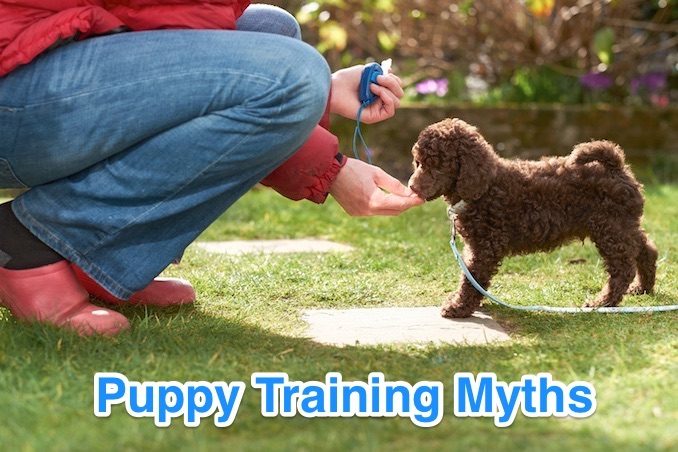
Myth 1. You Should Wait For Your Puppy to Grow Before Training
The most common and detrimental puppy training myth is that you should wait for your puppy to grow up a little bit before you start training. The earlier you start educating yourself about puppy training the better.
The most successful cases I see begin educating themselves about training before the puppy even comes home.
There are some fantastic puppy books out there, my favorite is Perfect Puppy in 7 Days by Sophia Yim.
Reading one or two books prior to your puppy coming home is a great idea.
Most trainers are also more than happy to do a pre-puppy consult to help you know exactly what to expect when your puppy comes home.
A trainer can help you be prepared to handle the normal challenges of puppyhood, such as house training, chewing, crate training, puppy biting, jumping and barking.
Puppies are learning from the moment you bring them home.
If you are not consciously training your pup to do the right thing, you may end up needing to correct problem behaviors down the road.
It is always easier to help your puppy be successful versus trying to correct inappropriate behaviors that have become habit – via Sarah Fricke.
Myth 2. Puppies Need To Be 6 Months Old to Start Training
The most important puppy training myth to dispel is that puppies need to be at-least 6 months old to start training. Training and socialization needs to start right away. If puppies are enrolled in a good positive reinforcement socialization class the instructor could do much to dispel all the other myths surrounding puppy training – via Jean Kolor.
Myth 3. Expecting a Puppy to Understand
Some people expect their puppy to understand what they’re supposed to do, without taking the time to train them. Training is such a great bonding experience for the puppy and family as well as teaching how we want the pup to behave – via Beth A Smith.
Myth 4. Fear Imprint Cycle
To wait until they have ALL their vaccinations to start training. The sooner the better! The most important fear imprint period is from 7-16 weeks of age making that a critical period of time for Socialization and to start training – via Cathy Munnier.
Myth 5. Puppies Can’t Leave The House Until After Vaccinations
The most common puppy myth, and one that can lead to the most serious behavioral issues later in a dog’s life, is that a puppy is not allowed to leave the house until all vaccinations are complete – via Danicia Ambron.
Myth 6. No Age Limit on Training
I believe that a super common training myth is putting an age limit on training. A pup is ready at a very young age to learn many different things like how to be handled by different people, how to react nicely when people touch their food source, etc. Also, a dog is never “too old” to learn new things! If you are consistent with your training methods, a dog at any age can learn – via Shawna Hoole.
Myth 7. Puppies Know Bad Behvaior
The most common puppy training myth is that puppies know when they did something wrong. Puppies read your body language and if you appear to be upset then they will shy away from you and not really understand why you aren’t happy – via Cheryl Connolly.
Myth 8. Dominance Theory is Correct
Dominance myth is the most common (and most damaging!) dog training myth at all ages – via Melanie Berky.
Myth 9. Training Lasts a Lifetime
Once trained, your puppy stays trained for the rest of his life – via Mallory Robinson.
Myth 10. Bad Behavior is Grown Out Of
Puppy’s grow OUT of bad behavior – via Katen Widaman
Summary
Training your puppy is an important experience between you and your dog.
It helps to create trust, loyalty and also a bond between the two of you.
This bond can be used for sophisticated training, behavior correction and a lifetime of friendship.
Don’t start too late, make sure to use positive based training and socialise your dog whilst young to avoid some of the most common training mistakes and myths.
If you have just started training your puppy or a new dog, feel free to share your progress with us or ask any of our behavior experts on specific training advice using the comments section below.
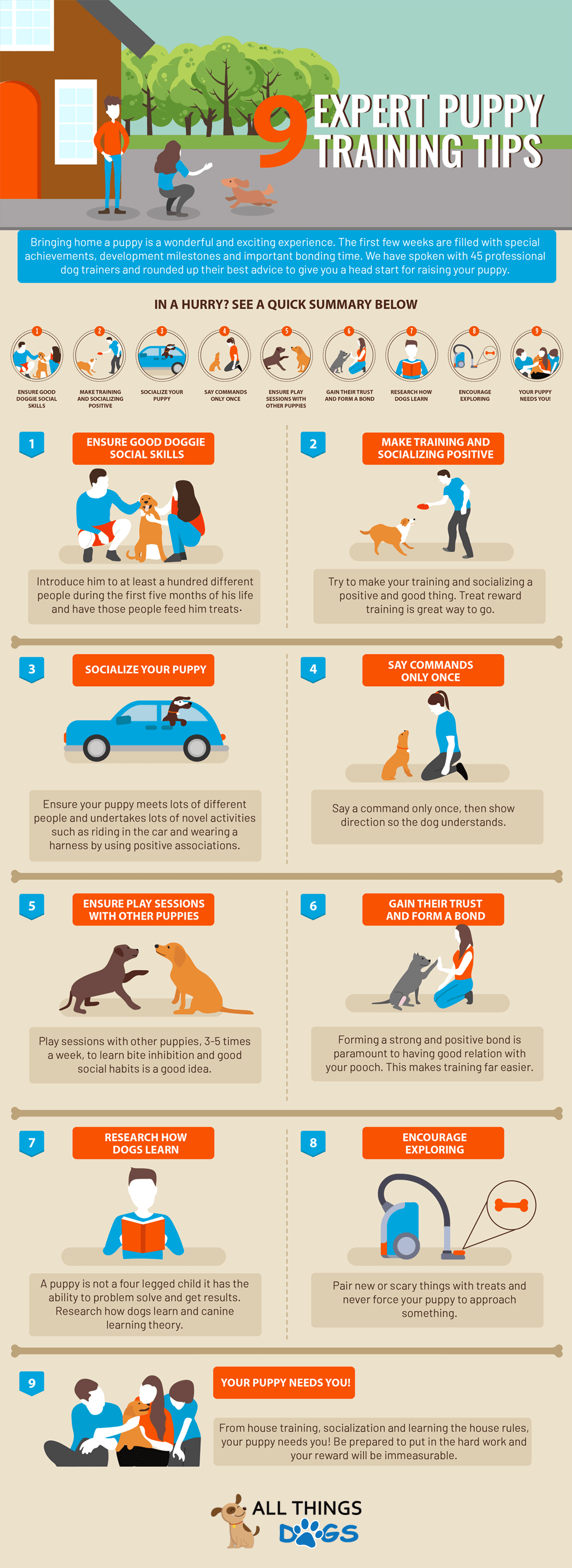

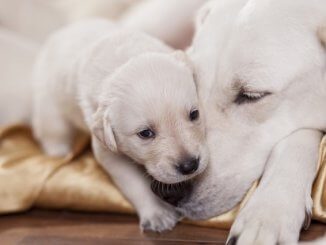
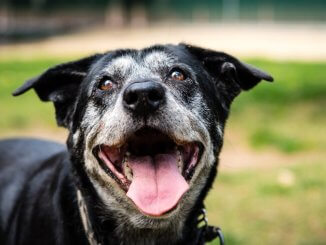
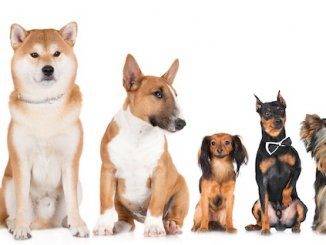
I have a 11 week old Chi. She dies not want to stop putting her teeth on our skin. She usually doesn’t chomp down, but still is an unwanted habit. Help?
Hi Linda, try using positive techniques when it comes to adjusting this behavior. You can try withdrawing attention from your puppy as soon as her teeth touch your skin and also provide alternatives for her to play with such as toys or a chew rope. You can read more about this here
https://www.allthingsdogs.com/how-to-stop-a-puppy-from-biting/.
I have a 5 month old Mastiff/Labrador mix ( mostly Mastiff ). How do I stop her from jumping up on people?
Hi Tom, this will be a learned behaviour as it is likely your dog has greeted you like this, and you have rewarded them with attention and praise. The fastest way to revert this behaviour is to simply stop giving your dog attention for this type of behaviour when you return home. You can read more about positive reinforcement dog training, this technique looks to reward and praise positive behaviour and to re-direct or ignore unwanted behaviour.
How can I stop my 1 year old English Bulldog from chasing skateboards and scooters? I’ve done so much training with her and she’s fantastic, but once she hears and catches sight of a skateboard or scooter, she doesn’t even seem to hear me; she’s in a whole other zone. I firmly say “Sit” (with clicker and treat ready) but it’s pointless. She wails! She screams and screeches! She flies in the air! Help!
Hi Leigh,
Has your dog ever had a bad experience with a skateboard or scooter? If so, it may take a little more work and perseverance.
The idea is to desensitise her to skateboards and scooters and then counter-condition.
In short, help her learn that they’re nothing to be wary of, she doesn’t have to chase them, she can simply ignore them. If possible, ask friends or family members if they have a scooter or skateboard that you can borrow to start your training. Failing that, see if you can get a second hand one off Craig’s List.
Start by just having the scooter or skateboard just lying around the house or yard (not where anyone is likely to trip over it in the middle of the night). Let your dog sniff it, when it’s not moving.
Intermittently throw treats in the general direction of the scooter or skateboard. You want her to associate it with good things. Once she’s confident being around it, you can start rolling it briefly around the house, again praise and reward her if she’s anywhere near. You want her to get used to the noise of the wheels.
Next, ask a helper to simply stand on the skateboard or scooter, in the yard. Praise and reward your dog and providing she’s confident, throw treats in the general direction of the person and scooter/skateboard.
Eventually, you should be able to build to, someone slowly rolling on the skateboard/scooter in the yard. As long as she can’t escape, keep her off-leash at all times during this training. She needs to be able to take herself away if she starts to get stressed.
Once you are confident she is tolerating the items in the yard, ask your helper to come out on to the street and roll slowly, either next to you or further away. This is where she may behave different because she’s not in her safe-haven at home. Stay positive and use plenty of praise and reward providing she’s seems happy and calm.
Next, take her to a park, and with someone on a scooter or skateboard, in the distance, start building her tolerance. Before she’s even noticed it, keep her attention on you with some treats. Slowly decrease the distance between you and the scooter/skateboard and keep treating her. The aim is to get as close as you would ever be to the scooter/skateboard without her reacting.
If she starts to get stressed; lunging, barking etc. Increase the distance again.
Be patient, it does work, but it can be a long process. If you are concerned that she is putting herself or you in danger through her behaviour, seek the advice of a qualified behaviourist.
I have a Pomeranian he doesn’t want to learn how to pee on the pads. Any guidance on house breaking?
Hi Kooka,
How quickly you can housebreak your Pom will largely depend on how old he is. If he’s a puppy, you will likely achieve it much quicker than an older pooch. Be patient, you will get there.
It’s important to get into a routine with house-breaking. Take him out to pee as regularly as possible; first thing in the morning, after every meal, after play time and last thing at night. You should take him out at least every two hours in between to limit the chance he’ll go potty indoors.
He needs to learn where he can pee. Place puppy pads in the spots he usually chooses to pee, but ideally he should only use them as a last resort.
When he does pee outside or uses the puppy pads, praise and reward him. But only when he has gone-potty. If you praise during, you’ll just distract him and stop him mid-flow. We know that dogs are more likely to repeat a behaviour if they get something good in return!
The most important thing is to set him up to succeed. As much as possible, give him the opportunity to go-potty outside, but, if you do want him to learn to use the pads, praise and reward him just as much when he does.
If he has an accident somewhere else in the home, don’t punish him. Simply guide him to the pads. It’s also important to thoroughly clean the area to remove the scent – dogs are more likely to toilet where they have done before; white vinegar is brilliant at removing odors.
Hi John, my husband and i got two malinois/shepherd mix puppies at three months old (a male and a female). I didn’t recommend it because of the bonding with each other not with us notion, but my husband went ahead and got them both… This is the challenge, they will not allow us to touch them at all. The female is truly a remarkable puppy curious intelligent, playful and interacts relatively well with my husband and I. The closest we can get is her licking our fingers or our toes. Her brother will not come within a foot (maybe six inches if i try to feed him treats) She will eat from my hand he absolutely will not. I figure this is due to a lack of socialization when they were born. As you can imagine we cannot get a collar or a leash on them. My husband tried with the male, but that didn’t go well. Unfortunately we don’t have training schools were we live. All in all, they seem pretty happy and play and sleep as puppies do. I know we need to be patient but worry we are doing something wrong?
Hi Karen,
Thanks for your question. I understand your concern, these pups will grow into large dogs, who won’t be easy to manage if they dislike people. I’m interested more in where you got them from? Do you know much of their experiences before they came home with you?
You are absolutely correct, you do need to be patient. They are wary, we’re just not entirely sure why yet.
You mentioned socialisation? What sorts of things are you managing to expose them to?
They need to make the decision to come to you, it can’t be forced and if they are that wary, lures are often totally ineffective. Just let them exist and watch you from afar. They need to learn that they are safe and you aren’t so bad afterall. You could start with throwing treats on the floor towards them, so they learn you are the giver of treats. Stick with this approach for a few days/weeks. As they get more confident (quicker to approach and eat treat, paying more attention to you), slowly decrease the distance you throw the treats, so they have to get closer to you. I appreciate you said they will get within a foot, but it’s helpful to start with the basics so you can figure out more of what’s going on. Don’t make a big deal of it, throw a treat and carry on with whatever you are doing.
Do they play much? You could invest in a flirt pole? They can play without having to come too close to you?
They need to associate you with good things, and that can take time as we don’t know their history. Patience is key and stay positive. If you do become more concerned about their behaviour, please seek advice from a qualified behaviourist.
Hello!
I’m just fostering to adopt right now. I really wanted this 10-11 week husky mix, but I’m noticing stuff that’s making me anxious and hesitant about finalizing the adoption. The puppy is young and I know she needs to relieved in the middle of the night but when we go outside and come back she’s so awake and wants to play, starts to bite. Her crate is currently in the bedroom and she’s fine sleeping until she wakes up is like 4:00-5:00 am to go outside. How can I get her to go back to sleep in her crate without whining or barking. I am losing so much sleep and I’ve only had her for 4 days. I live in an apartment and don’t want her waking up neighbours.
The fact that she’s holding right through to 4-5am is commendable in such a young pup! By that time, she’s had her sleep and she’s ready to start the day. As difficult as it is, it’s probably best to get up with her at that time. She’ll soon settle into more of a routine and once she can hold her bladder for longer, she may not wake as early.
The good thing about fostering is that you can see if this particular dog suits your lifestyle. A husky mix is always going to have bags of energy, so you’re right to consider whether you want to continue with the adoption process. Well done for putting the needs of the dog at the forefront of your mind and good luck with your decision.
Our rescue puppy is 5 months old and has been home with us for a week and a half now. He was sleeping pretty good up until a few nights ago (waking just once or sleeping about 5-6 hours straight). The last 3 nights he’s gotten up 3-4 times and we’re afraid he’s developing a bad habit of waking frequently just for the opportunity to leave his crate briefly. He’ll go back in right away but does whine and bark a bit before settling back down only to wake us again 1-2 hours later. Any suggestions to get him back to sleeping longer for us?
Hi Katie,
You say he is a rescue? What’s the history? Did something change a few nights ago? Did he have a new experience? Or did something startle him? Has your routine changed at all? Does he toilet when you let him out of his crate? With a little more information, we’d be better positioned to help you manage this new behavior.